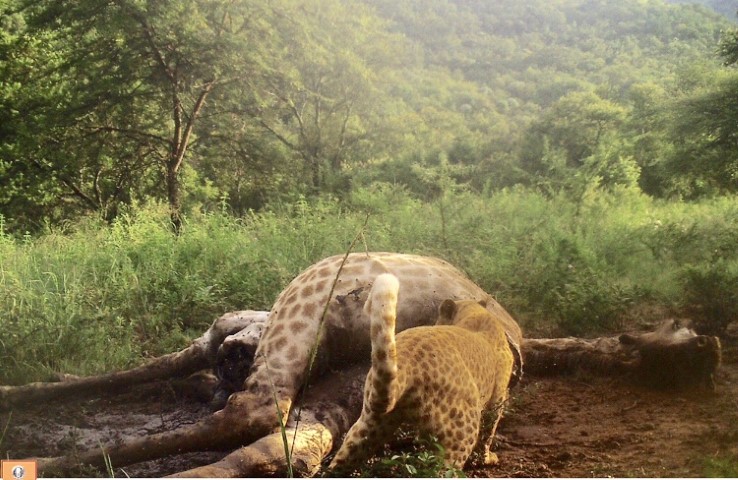An erythristic leopard was recently captured on camera eating a giraffe carcass, a sighting that is extremely rare.

The leopard feasts on the giraffe carcass. Photos: Black Leopard Mountain Lodge website
Recent photos of the extremely rare erythristic leopard gave nature lovers something to roar about.
The photos, described as some of the clearest ones of the leopard to date, were circulated on Facebook at the end of July, reports Lowvelder.
“I still believe it is a golden leopard. Because they are so rare, I believe I have the right to call her gold,” Alan Watson, owner of the Black Leopard Mountain Lodge and its coexisting wilderness conservation reserve, Thaba Tholo, said.
ALSO READ: Toddler killed by leopard to be buried on Sunday
Watson explained he and his wife were headed to the lodge in January when they saw the carcass of the giraffe.
“There was a storm, but we could not see any lightning damage that had killed the giraffe. We presumed it was a pregnancy gone wrong and that the giraffe might have died of a heart attack. Instead of removing the carcass, we decided to set up a camera to monitor the animals we knew would be feeding on it.”
Watson explained that the conservation reserve had camera traps all around the area, which were monitored on a monthly basis. Upon looking at the footage of the camera after a month, Watson was surprised to find footage of the leopard.
What is an erythristic leopard?
Mpumalanga Tourism and Parks Agency’s carnivore scientist, Gerrie Camacho, explained the colour variant of the animal is caused by a mutation in its genes.
“A leopard with this colour is born when two leopards with the recessive erythristic gene mate.”
According to him, these leopards are seen in the Lydenburg region as well as in North West, and the first photographic evidence of a leopard of this nature in the Lydenburg area was recorded in 2013.
“The reason for these animals becoming more prevalent in certain regions could be because of the population becoming smaller due to hunting of, for example, the bigger males. This means leopards from the same bloodline, both carrying the recessive gene, mate with one another and a leopard like this one is born.”
Camacho believes it is in fact called a red leopard as the mutation occurs on the red pigmentation gene of the leopard.
For more news your way, download The Citizen’s app for iOS and Android.
Download our app







